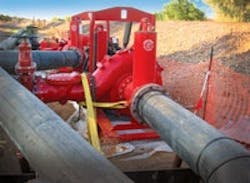Under Pressure
In an emergency pumping application, it is unlikely that the best-suited equipment will be in place for the situation. It is sometimes necessary to determine how to make available equipment meet the performance well enough to get through the initial emergency. This often is a challenge in lift station applications because one must meet either flow or pressure requirements.
In these cases, the easiest solution is to achieve additional volume. It is common to use a number of smaller pumps to achieve larger flows. As long as the individual pumps can meet the head requirements, the flows from each pump can be combined and added. This may be through individual discharge lines or in a common manifold.
For higher-pressure applications, it is possible to use multiple pumps by combining them in series. By routing the discharge of one pump into the suction of another, it is possible to boost the pressure that the system will produce. The volume will remain unaffected. The key factors to consider in this situation are whether the pumps will meet the desired flow and handle the initial pressure, and then balancing the performance of the pumps in series.
Real-Life Scenarios
The following are two cases in which the same pumps were used to achieve different results.
On Project A, a sanitary sewer line had to be bypassed in order for repairs to be made to a collapsed section of pipe. It was necessary to achieve flows up to approximately 14,000 gal per minute (gpm) at 45 ft of head. Multiple 18- and 10-in. pumps were combined in order to achieve the desired flow, which was greater than any single pump could produce. The suction of each pump was placed in the flow and then the discharge was routed to a common manifold.
For this project, it was possible to run only the pumps needed to meet current flows. If the flow increased, the additional pumps were started.
On Project B, a lift station unexpectedly went down and the operator needed to meet a high head condition. The pumps that were readily available were high-volume pumps. By reviewing the pump curve, it was observed that if the two pumps were combined in series, they could achieve the desired performance.
On start-up for the pumps in series, there were a number of challenges, such as achieving prime, meeting pressure and maintaining horsepower. Even though a pump may be generating flow and pressure, if it is not operating at a proper speed to maintain horsepower on a variable rpm motor, such as a diesel engine, then it will not overcome the system head.
It is possible to combine multiple pumps in series or in parallel to achieve higher volume or higher pressure depending on the application. It starts with an understanding of the pump curve and the application. It is not always an ideal situation, but knowing the possibilities allows operators to respond and increase pumping capabilities with the proper combination of existing equipment.
Download: Here
